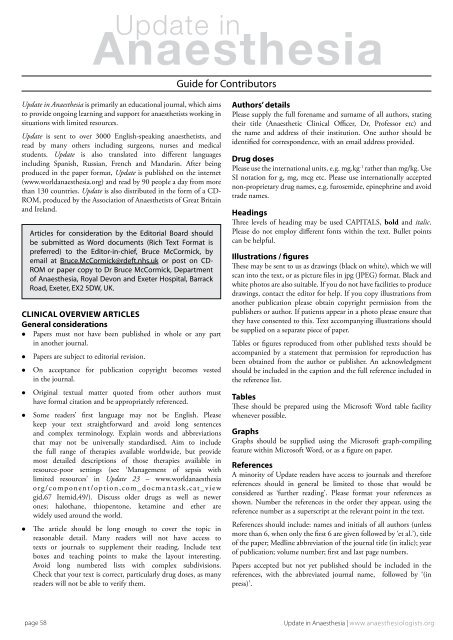Surgically placed rectus sheath catheters - The Global Regional ...
Surgically placed rectus sheath catheters - The Global Regional ...
Surgically placed rectus sheath catheters - The Global Regional ...
You also want an ePaper? Increase the reach of your titles
YUMPU automatically turns print PDFs into web optimized ePapers that Google loves.
Update in<br />
Anaesthesia<br />
Guide for Contributors<br />
Update in Anaesthesia is primarily an educational journal, which aims<br />
to provide ongoing learning and support for anaesthetists working in<br />
situations with limited resources.<br />
Update is sent to over 3000 English-speaking anaesthetists, and<br />
read by many others including surgeons, nurses and medical<br />
students. Update is also translated into different languages<br />
including Spanish, Russian, French and Mandarin. After being<br />
produced in the paper format, Update is published on the internet<br />
(www.worldanaesthesia.org) and read by 90 people a day from more<br />
than 130 countries. Update is also distributed in the form of a CD-<br />
ROM, produced by the Association of Anaesthetists of Great Britain<br />
and Ireland.<br />
Articles for consideration by the Editorial Board should<br />
be submitted as Word documents (Rich Text Format is<br />
preferred) to the Editor-in-chief, Bruce McCormick, by<br />
email at Bruce.McCormick@rdeft.nhs.uk or post on CD-<br />
ROM or paper copy to Dr Bruce McCormick, Department<br />
of Anaesthesia, Royal Devon and Exeter Hospital, Barrack<br />
Road, Exeter, EX2 5DW, UK.<br />
Clinical Overview Articles<br />
General considerations<br />
• Papers must not have been published in whole or any part<br />
in another journal.<br />
• Papers are subject to editorial revision.<br />
• On acceptance for publication copyright becomes vested<br />
in the journal.<br />
• Original textual matter quoted from other authors must<br />
have formal citation and be appropriately referenced.<br />
• Some readers’ first language may not be English. Please<br />
keep your text straightforward and avoid long sentences<br />
and complex terminology. Explain words and abbreviations<br />
that may not be universally standardised. Aim to include<br />
the full range of therapies available worldwide, but provide<br />
most detailed descriptions of those therapies available in<br />
resource-poor settings (see ‘Management of sepsis with<br />
limited resources’ in Update 23 – www.worldanaesthesia<br />
org/component/option,com_docmantask,cat_view<br />
gid,67 Itemid,49/). Discuss older drugs as well as newer<br />
ones; halothane, thiopentone, ketamine and ether are<br />
widely used around the world.<br />
• <strong>The</strong> article should be long enough to cover the topic in<br />
reasonable detail. Many readers will not have access to<br />
texts or journals to supplement their reading. Include text<br />
boxes and teaching points to make the layout interesting.<br />
Avoid long numbered lists with complex subdivisions.<br />
Check that your text is correct, particularly drug doses, as many<br />
readers will not be able to verify them.<br />
Authors’ details<br />
Please supply the full forename and surname of all authors, stating<br />
their title (Anaesthetic Clinical Officer, Dr, Professor etc) and<br />
the name and address of their institution. One author should be<br />
identified for correspondence, with an email address provided.<br />
Drug doses<br />
Please use the international units, e.g. mg.kg -1 rather than mg/kg. Use<br />
SI notation for g, mg, mcg etc. Please use internationally accepted<br />
non-proprietary drug names, e.g. furosemide, epinephrine and avoid<br />
trade names.<br />
Headings<br />
Three levels of heading may be used CAPITALS, bold and italic.<br />
Please do not employ different fonts within the text. Bullet points<br />
can be helpful.<br />
Illustrations / figures<br />
<strong>The</strong>se may be sent to us as drawings (black on white), which we will<br />
scan into the text, or as picture files in jpg (JPEG) format. Black and<br />
white photos are also suitable. If you do not have facilities to produce<br />
drawings, contact the editor for help. If you copy illustrations from<br />
another publication please obtain copyright permission from the<br />
publishers or author. If patients appear in a photo please ensure that<br />
they have consented to this. Text accompanying illustrations should<br />
be supplied on a separate piece of paper.<br />
Tables or figures reproduced from other published texts should be<br />
accompanied by a statement that permission for reproduction has<br />
been obtained from the author or publisher. An acknowledgment<br />
should be included in the caption and the full reference included in<br />
the reference list.<br />
Tables<br />
<strong>The</strong>se should be prepared using the Microsoft Word table facility<br />
whenever possible.<br />
Graphs<br />
Graphs should be supplied using the Microsoft graph-compiling<br />
feature within Microsoft Word, or as a figure on paper.<br />
References<br />
A minority of Update readers have access to journals and therefore<br />
references should in general be limited to those that would be<br />
considered as ‘further reading’. Please format your references as<br />
shown. Number the references in the order they appear, using the<br />
reference number as a superscript at the relevant point in the text.<br />
References should include: names and initials of all authors (unless<br />
more than 6, when only the first 6 are given followed by ‘et al.’), title<br />
of the paper; Medline abbreviation of the journal title (in italic); year<br />
of publication; volume number; first and last page numbers.<br />
Papers accepted but not yet published should be included in the<br />
references, with the abbreviated journal name, followed by ‘(in<br />
press)’.<br />
page 58<br />
Update in Anaesthesia | www.anaesthesiologists.org
















